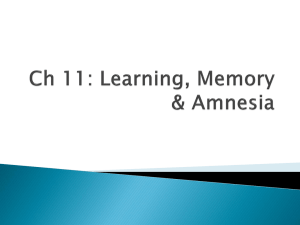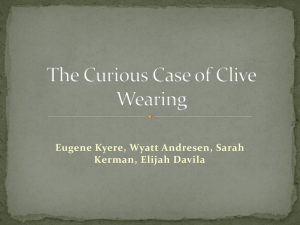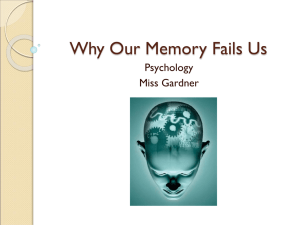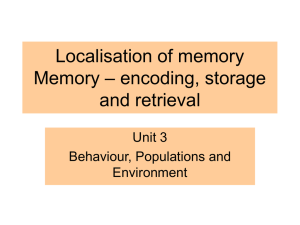memory (FILE minimizer) PowerPoint
advertisement
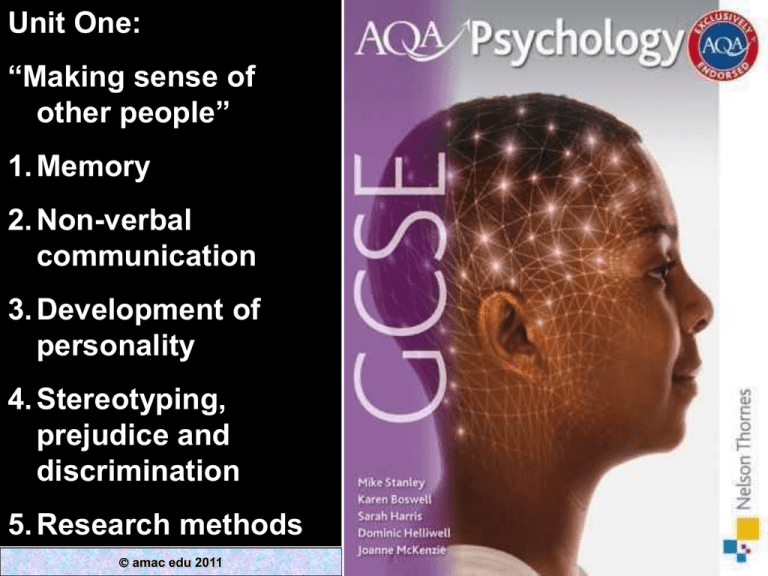
Unit One: “Making sense of other people” 1. Memory 2. Non-verbal communication 3. Development of personality 4. Stereotyping, prejudice and discrimination 5. Research methods amac edu 2011 Memory: famous quote by William James (c1890) “To constantly remember everything all the time, would probably be worse than remembering nothing at all” Concept: Primary & Secondary Memory A typical definition of memory: “Systemised storage of information based on experience in which these events are processed and are stored ready for use and this information can be utilised for past, present or future”. (Take notes under following headings) • Past………………………. • Present………………….. • Future…………………… What has memory to do with making sense of other people? Amygdala Frontal Cortex Hippocampus Cognitive Neuroscience Memory (1.1) The Multi-Store Model (Atkinson and Shiffrin, 1968) Key terms / concepts: Encoding Storage Retrieval Attention Sensory Store LTM Store STM Store Sensory Store The Multi-Store Model cont… Serial flow of information (processes): Encode > Store > Retrieve (Draw as a ‘Box & arrow’ Diagram) Concepts: Cognitive Psychology Receiving information: ‘The Cocktail Party Effect’ The Multi-Store Model cont… Store Sensory Store Attention Short – term Store Recall Task: Explain how the model works: Long – term Store MSM: Characteristics of the stores (and how we know) Memory Store Sensory Duration Capacity Less than one second Very limited Short-term 20-30 seconds Peterson & Peterson (1959) 7 +/- 2 chunks of information Miller (1956) Infinite Infinite Bahrick et al (1975) ‘Lexical Capability’ Murdock (1962) Long-term How do we know (1): Do AMRC Peterson & Peterson (textbook p10) I will run through simple AMRC’s for Bahrick et al (1975) & Miller (1956) Concepts: Infinite / Finite Lexical Capability What does ‘et al’ mean? How do we know (2): Murdock (1962) Total Recall 1 3 2 First words LTM Store Primacy Effect Middle words Rehearsal Last words STM Store Recency Effect Do AMRC p10 textbook. Copy above, define ‘Primacy & Recency Effect’ and explain what is going on at points 1/2/3 and how does this support the model? Concept: Schemata (pl. schema) • One of the most important concepts in cognitive psychology: “A complex bundle of information or associations stored in the brain which cognitively represents something, often in a vague sort of way” It can be: an object, stored general knowledge, how to do something or an event. You have never seen these particular things before, so how do you know that they are all windows except one? (1.2) Other explanations of memory: Bartlett (1932) A Study of Reconstructive Memory Fredrick Bartlett created the expression: ‘RECONSTRUCTIVE MEMORY’ Concept: Reconstructive Memory • Memory is deconstructed in storage (simplified like ‘semantic bullet points’) and reconstructed in recall (create a coherent narrative from incomplete information). We only store and recall significant detail. Memory is not a second by second video recording of the past. Memory is more like a reporter’s shorthand note book. If reconstructed from incomplete detail, how accurate? Bartlett’s research involved…… ‘Serial Repetition’ (define…..) of stories such as ‘War of the Ghosts’ • The people came down to the water and they began to fight, and many were killed. But presently the young man heard one of the warriors say, "Quick, let us go home: that Indian has been hit." Now he thought: "Oh, they are ghosts." He did not feel sick, but they said he had been shot. • So the canoes went back to Egulac and the young man went ashore to his house and made a fire. And he told everybody and said: "Behold I accompanied the ghosts, and we went to fight. Many of our fellows were killed, and many of those who attacked us were killed. They said I was hit, and I did not feel sick." • He told it all, and then he became quiet. When the sun rose he fell down. Something black came out of his mouth. His face became contorted. The people jumped up and cried. • He was dead. Extract from ‘War of the Ghosts’ and serial repetition of weird pictures……… Recognise the picture? What Bartlett found with the story: The UK participants tended to: Shorten it from 320 words to about 180 words in one repetition (memory does simplify & shorten). Sharpen it to create an understandable Cowboys & Indians story in terms of western culture. So based on existing schema (existing knowledge) What Bartlett found with the pictures: Bartlett deliberately chose pictures that were confusing (original picture was sort of half-bird and half-cat) Therefore how would we store the memory? (slowly create a picture based on existing schema eg. cat or bird) Over to you….. Do AMRC’s for: • Bartlett (1932) p12 • Wynn and Logie (1998) p13 (1.2) Another explanation of memory…… • Craik and Lockhart (1972) “Levels of Processing” (Looks like) (Sounds like) (what it means) Surface >>>>>>>>>>>>>>>>>>>>>>>>> Deep Which is best for recall? Experimental evidence (Craik & Lockhart, 1972) 1. Is this word upper or lower case and typed or handwritten ? Car Structural process, little brain activity, 15% recall 2. Listen to sound of the word “CAR” Phonetic (sound) process, increased brain activity,35% recall 3. What is a car and what do you use it for? Semantic (meaning) process, very active brain, 70% recall How do we know about levels of brain activity?... Brain scanning • CAT • PET • MRI • fMRI Over to you….. • Suggests that unlike the MSM, there is more than just rehearsal involved in the process of storage • This model has practical applications for learning strategies…. (Don’t just look or listen, try to understand…) • Do an AMRC for Craik and Lockhart p14 A task for you… 1. Define the following words: Encoding, Elaborative Rehearsal, Deconstruction & Reconstruction, Coherent Narrative, Semantic, Salient Semantic Bullet Points, Schema, Phonetic, fMRI / PET scans. (Try and use them in the tasks below) 2. Briefly outline the three explanations of memory (MSM, Reconstructive, LoP) 3. State what each of these explanations suggest about memory Hand-in……….. (1.3) Why we forget? • Memory is a great mystery. It can involve all our senses (vision, sound, smell etc). We can have vivid memories from years and years ago. Yet we can also forget something from literally seconds earlier. ‘Tip of the tongue effect’ • What it is… • Why it happens… Anna Kournikova (1.3) Why we forget? If you are very good at table tennis, why might this be a problem if you decided to take up tennis? Try to use the word interfere or interference (1.3) Why we forget: Interference Define the following: • Interference • Semantic confusion • Retroactive interference* (old<<<<new) • Proactive interference* (old>>>>new) • Release from proactive interference (*illustrate in terms of old friend’s name and new friend’s name) Recall Proactive Interference (old on new) 1. Names 2. Names 3. Names 4. Colours Copy and explain what is going on… Retroactive Interference (new on old) • Do an AMRC for Underwood & Postman (1960) p17 List 1 List 2 + + (1.3) Why we forget: Context (Context Dependency) • Define ‘context’ in terms of learning environment: • Do AMRC for Godden & Baddeley (1975) • Apply to learning and exams: • Apply to Police reconstructions of crimes: Are forgetting and remembering the same concepts? Remembering and Dependency Theory Define: • Context Dependency • Cue Dependency • State Dependency Memory ‘pegs’ (1.3) Why we forget: Amnesia Amnesia in simple terms, is the temporary loss of memory or permanent loss of memory. The cause can be physical of psychological Define: Anterograde, Retrograde, Hippocampus and morbidity Organic Amnesia: includes damage to the brain, usually through ‘stroke’ trauma, disease or sedative substance abuse (eg. alcohol, especially long-term abuse). Functional or Psychic Amnesia: is caused by psychological factors, such as shock or defense mechanisms eg. Hysterical posttraumatic amnesia. Movies & Amnesia: Retrograde LTM: Deficit (-) STM Preserved (+) “The common perception of ‘Bump-on-the-Head’ and forget who you are amnesia” How might this affect behaviour? Clinical Amnesia (1): Retrograde Korsakoff’s Syndrome (Butters & Cermak, 1980) Long term alcohol abuse, leaving preserved STM (they might know where they are) but a serious deficit in LTM (they can’t remember how they got there!) Movies & Amnesia: Anterograde STM deficit (-) LTM preserved (+) “Not as common as Reterograde and hard to understand” How might this affect behaviour? Clinical Amnesia (2): Anterograde K.F. (Shallice & Warrington, 1970) Motor bike accident patient K.F. left with serious deficit STM (impaired new memory) and preserved LTM (memory ok premorbidity*). *What does premorbitity mean? Damage here leads to STM deficit Make notes from textbook (p19): Miller (1968) & Russell and Nathan (1946) What do the diagrams above suggest? What is ‘GradedRetrograde Amnesia? Damage here leads to LTM deficit Advanced Issue: ‘Double Dissociation’ STM LTM Korsakoff’s (Retrograde Amnesia) LTM Damage, STM ok K.F. (Anterograde Amnesia) STM Damage, LTM ok So how does this support the MSM? A task for you… 1. Define and explain in terms of brain damage: Anterograde and Retrograde Amnesia. 2. Using your own resources outline another explanation of why we forget. 3. Using your acquired knowledge of remembering/forgetting, suggest a strategy for examination revision. Hand-in……….. How accurate is EWT? Eye Witness Testimony Factors which effect the accuracy of EWT: • Leading Questions •Unfamiliar faces •Context of recall (C.I.) •Stereotypes EWT (Court Room Setting) • Imagine that you were the witness to a fatal road traffic accident. • This is the sort of question that you might have to answer in court: “In your opinion, how fast was the car going as it approached the bend?” The problem is don’t actually know! So on what do you base your estimate? o Pre-event information? Stored memories of driving a car or being a passenger (schema driven… remember Bartlett) o Post-event information? Something after the event influences your estimation (eg. The wording of the question: “smashed into” vs “made contact with”). (cognitive ‘laziness’ driven) Which do you think has the strongest influence? Loftus & Palmer (1974): Leading Questions Question: “How fast were the cars going when they …… into/with each other” ? Incident Verb: + Estimated Speed: Smashed Collided 40.8 mph Bumped 38.1 Hit 34.0 Made contact 30.8 External Info = How fast when …. & any broken glass? (Leading Q’s) 39.3 Possibl e False Memory ? Do AMRC p21 ‘Loftus & Palmer’ (1974) What type of graph is this and why? 40.8 39.3 38.1 34 30.8 Loftus asked all her participants to rate their confidence in recall Famous quote: “Confidence in recall does not equate with accuracy in recall” Over to you: “A leading question contains the answer as desired by the asker.” So in court think how defence and prosecution may differ in style of questioning… However, in court……. A question will be over ruled by a judge if it is considered to be a: L ---------------- Q ---------------- You should now know why is this type of question objected to…. Do AMRC p21 Other factors: Unfamiliar faces • Bruce and Young (1998) You are only good at recognizing ‘familiar faces’. So much so that identity parades are considered unreliable and only in exceptional circumstances can they be accepted without other collaborating evidence. Concept: VIPER (Video Identity parade Electronic Recognition) Cognitive Interviews Other factors: Context (remember ‘dependency’) • Geiselman et al (1985) • Do AMRC p21 It mimics the way memory works: 1. Factual retrieval cues (context dependency: recreate the event) 2. Emotional retrieval cues (state dependency: recreate how you felt) Avoid ‘Leading Questions’ (re: Loftus) Links to Godden & Baddeley (Divers)

